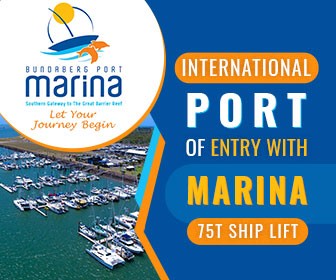Portrait of a Cruiser: Kimi and Phil Seeley
After a yacht charter through Australia’s Whitsunday Islands whetted their appetite for the cruising life, Aussie sailors Kimi and Phil Seeley put the idea on hold for a while. But a global pandemic made them re-think their plans and in February 2022 they left their home port of Melbourne with a rough plan to complete a circumnavigation. They recently crossed the Indian Ocean to Tanzania. Here’s their story.
Published 1 year ago
Names of Owners (and crew): Kimi and Phil Seeley
Nationality: Australian / British
Boat Name: Cielo
Boat Type/Model and Size: Island Packet 420, 44ft cutter rig
Home Port: Melbourne, Victoria, Australia
Facebook: https://www.facebook.com/sailingcielo
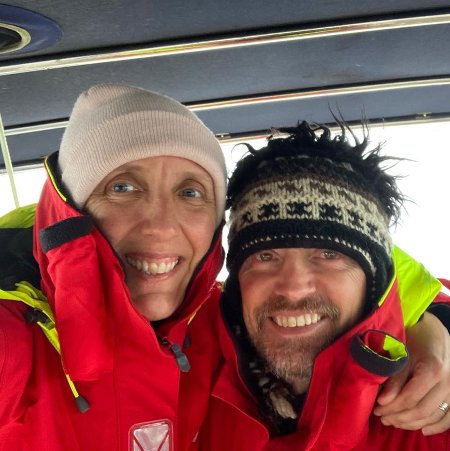

How did you start cruising?
We chartered a boat in the Whitsundays about five years ago to see if Kimi liked it. Having had an overall positive experience, we thought it was something we would do when we were older and had retired at the traditional age, in another 10-15 years.
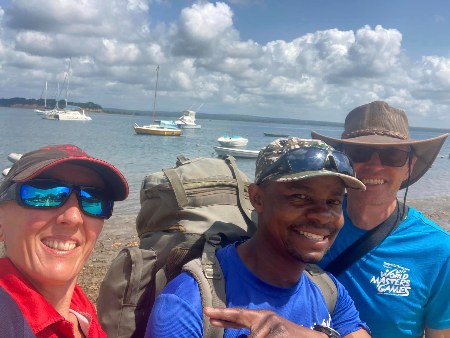

The pandemic changed our thinking and we started researching boats in 2020 with a plan to eventually circumnavigate, but to stop in less usual places like Sweden and the Faroe Islands. As chance would have it, an Island Packet 420 was being sold in Australia at exactly the time we were looking and we bought the boat in early 2021. We sailed the boat down to Melbourne from NSW after several weeks of delays waiting out a 1 in 100 year rainfall event and three weeks of westerly winds once we had it at the Gippsland Lakes.
We spent the next year sorting through our possessions, selling or giving most of them away, putting the house up for rent and moving on board. In February 2022, we left our home port of Melbourne and set sail through The Rip at Port Phillip Heads, to Wilson’s Promontory (known locally as Wilson’s Prom) and then across the Bass Strait to Tasmania.
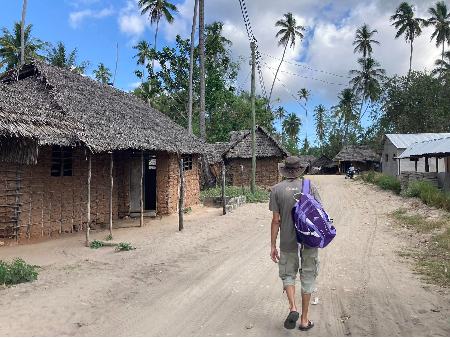

Describe what sort of cruiser are you:
We are living on board full time and cruising as a couple. We occasionally have family and friends come to stay on board with us, but we do all the long passages ourselves.
What type of cruising are you doing currently?
We are currently on our first circumnavigation. We recently crossed the Indian Ocean from Carnarvon, WA to Dar es Salaam, Tanzania via the Cocos (Keeling) Islands. It took 34 days in total and we had a really great passage.
We are just starting to make our way South after having spent the last two months in Tanzania. It will likely take us another few weeks to get to the southernmost part of the country before we can head across to Mayotte and hopefully afterwards Madagascar. Wind and weather permitting.
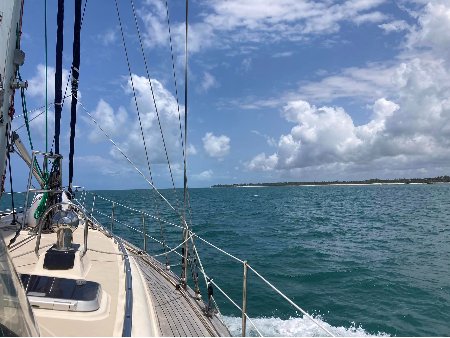

What were the key reasons you selected your current boat?
Comfort, sea kindliness. Built like a tank. Large water and diesel tanks. Easily handled by two people with minimal reasons to go outside the cockpit in bad weather. Good reputation. Large and active support group of owners and still supported by the factory in Florida. We wanted a boat that was better than us!
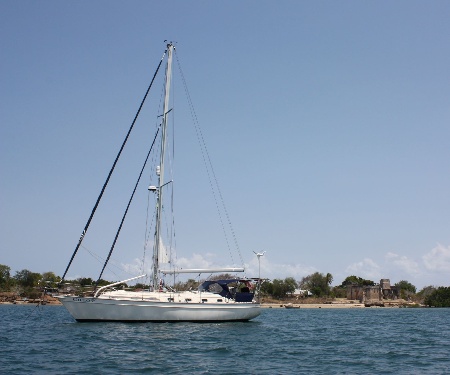

What other boats have you owned?
Phil had a dinghy and a windsurfer when he was younger and I had a kiteboard. This is our first big boat! We also own a couple of inflatable kayaks (they count don’t they?)
What changes have you made to your current boat?
We added a wind generator, a gas detector and new sails. We have in mast furling and the existing mainsail whilst not in a bad condition was stretched in the middle and having issues coming out of the mast although going back in was fine. A new tri radial cut main sail resolved the issue and we carry the old main as a spare. We also recently replaced the oven and the radar – the old radar had become waterlogged and stopped working.
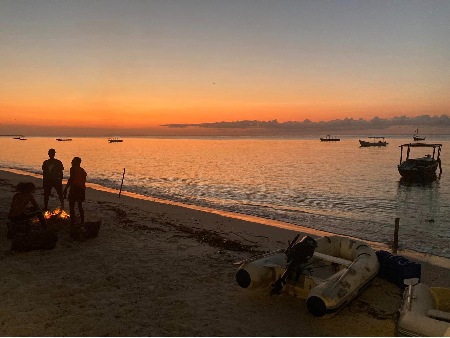

Most useful equipment fitted and reasons for this choice:
We have a large Samsung Tablet which acts as a backup to the two chart plotters. This connects using Wifi to a yacht devices dongle that broadcasts the messages from the seatalk network. We have also invested in a raspberry pi which hooks into the network the same way and writes the data to a database that we can then use modelling tools to analyse.
Sounds complicated, but instead of having to buy a new instrument to confirm to us that the wind is strengthening / easing / veering / backing we can look at the last 10 minutes or the last two hours of data to support our own observations. We can also see the impact of sail changes or trimming to our speed and use it to make better decisions. We are both from a technical background and this is fun for us.
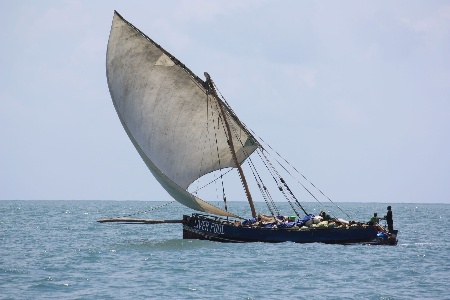

We also bought and fitted a wind generator and replaced the radar. When we are in stronger winds, the wind genenerator will keep the power requirements for autopilot and electronics ticking over nicely, even in the trades where it’s behind you, and at night when there is no solar. The radar can pick up rain and has helped us determine the direction in which storm clouds are moving so we can try and avoid them (particularly lightning). It’s also picked up a couple of boats that were not on AIS. We also have a hookah which makes it very easy to clean the hull. We are currently researching Lithium battery installations – there is a lot of information to sift through before we make any decisions on that.
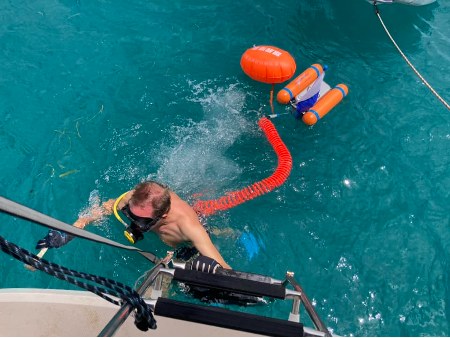

Equipment regrets, or things you would do differently?:
We “fat-fingered” the measurements for our new genoa whilst entering them into an email and ended up with a 1m shorter foot (and overall about 97%, so it’s a jib). However, this has worked quite well as the sail is much easier to manage and we haven’t had to reef down as much. We would also have put new lithium batteries in before we left Australia as our batteries aren’t working as well as they should be for their age. Something that wasn’t evident in the many miles of sailing we have done prior to leaving!
List the countries you have cruised:
Australia and Tanzania.
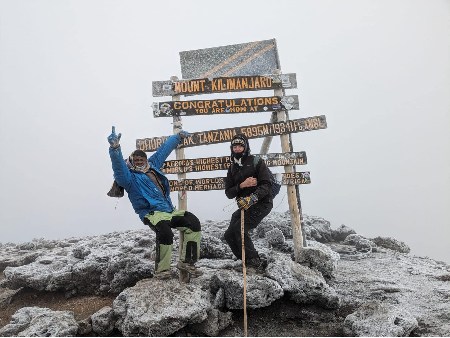

Future cruising plans:
Mayotte, Madagascar, South Africa, Namibia, (2023) St Helena, The UK, (2024) Sweden, The Faroe Islands (2025).
List the oceans/seas you have crossed:
Indian Ocean, Bass Strait, Great Australian Bight
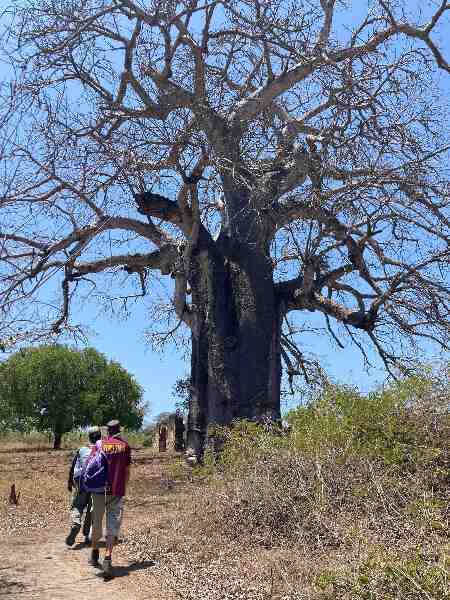
Approximate sea miles:
13100nm+
Scariest day on the water:
Probably leaving Flinders Island, Tasmania a couple of years ago to head North to Lakes Entrance, Victoria. We had been stuck for a few days at Prime Seal Island waiting for a strong westerly to go through and we knew that we needed to get on the back of it in order to be able to sail to Lakes Entrance.
We knew that it was going to be a bit sporty for the first couple of hours (which it was) and it should settle down as the winds and waves eased (which it did). We just had to hold on tight and be ready to take over if the autopilot struggled! There was one of us in the cockpit and one in the galley both holding on and bracing ourselves! We’ve had stronger winds and sea conditions since then, but this was about three months after setting sail so we were still relatively new to the boat.
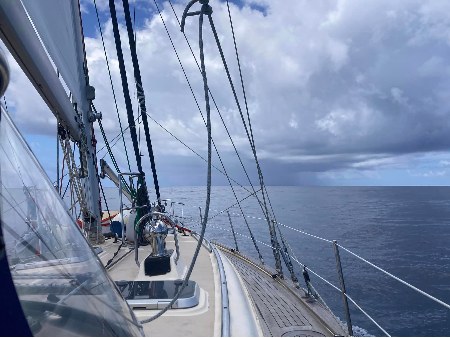

Best cruising moment:
Many many to choose from. First up we have met some incredibly kind and warm hearted people – both cruisers and onshore. It’s always hard to say goodbye to them! Last year, we had Christmas Dinner in Bathurst Harbour with a couple of friends we’d met in Tasmania the year before being only two of about five boats there in total.
Bathurst Harbour is in South West Tasmania and you can only get there by sailing, walking or light aircraft. It’s incredibly beautiful. We had some wonderful sailing conditions from Tasmania to Adelaide (in fact so good we didn’t stop along the way). The dolphins gave us an escort when we got to Robe (on the South Australian coast) in stunning turquoise waters.
Another time, we had a baby dolphin splashing us at the bow which was very funny and cute! More recently, we invited our Kilimanjaro guide Frank to come sailing with us in Tanga, Tanzania and the smile on his face when the wind caught the sails and the boat started picking up speed was priceless! As he lives six hours inland, it is likely not an experience he would otherwise have had.
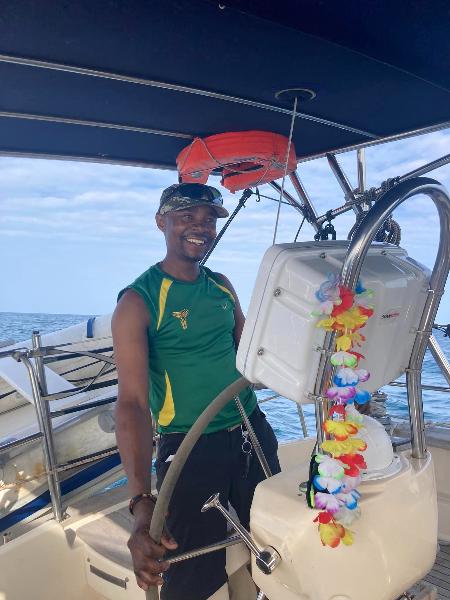

Anchored in flat calm water at Monkey Mia (Western Australia) with an incredible red sky sunset and dolphins leaping out of the water. Whales tail slapping (waving goodbye) as we leave the Whitsundays. We love the marine wildlife except when they make deposits on the solar panels!
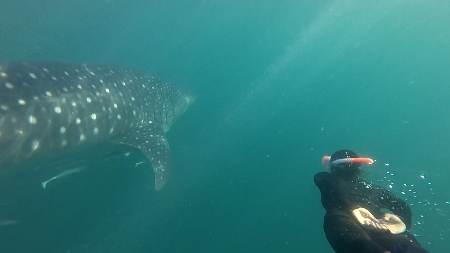

Favourite cruising area and why:
Tasmania, Australia (Dec to Apr). It has a bit of everything and the weather keeps you on your toes.
Favourite anchorage:
Direction Island, Cocos Keeling Islands for the crystal clear and warm water, friendly reef sharks, stunning coral. Bathurst Harbour, Tasmania for being surrounded by mountains and natural beauty.
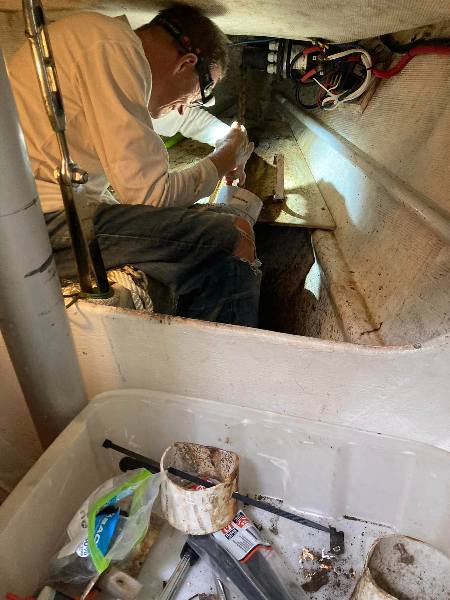

Favourite cruising apps:
Zulu offshore / zulu waterways, Predict Wind and Windy (Weather), Navionics, noforeignland.
Favourite cruising websites:
SV Soggy Paws, Sailing Yacht Florence, Noonsite (of course), Sailing Brothers, Sailing Fair Isle. Many others but these are ones that we’ve found useful recently.
Favourite cruising books:
100 magic miles (Whitsundays), Jimmy Cornells planners, Boatowners mechanical and electrical manual.
What advice or message would you want to pass on to anyone new to cruising or thinking about casting off the dock lines?
- Figure out what kind of cruising you want to do and get the appropriate boat for it.
- If you are keen to do some offshore or long passages, then build up to it. We increased our passages in length and difficulty as we went along and we never had a timetable or a plane to catch.
- We always have a plan B or C.
- We are ready to leave at short notice if the weather turns which is frequently does in Tasmania.
- Use checklists and set alarms to make sure you don’t forget to do a task (like put on nav lights).
Why cruise? In a few sentences, what is it that inspires you to keep cruising?
It’s a different way to see the world. We have our home with us wherever we go. We enjoy being surrounded by nature. We love meeting new people and learning their stories. We get to stay in places for a decent chunk of time and learn more about them than we would if we flew in and out on a two week holiday.
Kimi and Phil Seeley
SY Cielo
……………………………………
Related Content:
More Portrait of a Cruiser stories
If you think you have an interesting story to tell and would like to take part in our Portrait of a Cruiser series, please contact Sue at editor@noonsite.com for a questionnaire.
……………………………………..
The opinions expressed in this article are the author’s own and do not reflect the view of Noonsite.com or World Cruising Club.
……………………………………
Find out all news, reports, links and comments posted on Noonsite, plus cruising information from around the world, by subscribing to our FREE monthly newsletter. Go to https://www.noonsite.com/newsletter/.
Related to the following Cruising Resources: Circumnavigation, Indian Ocean, Portrait of a Cruiser, Routing






